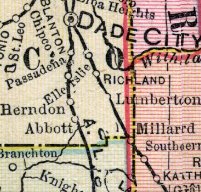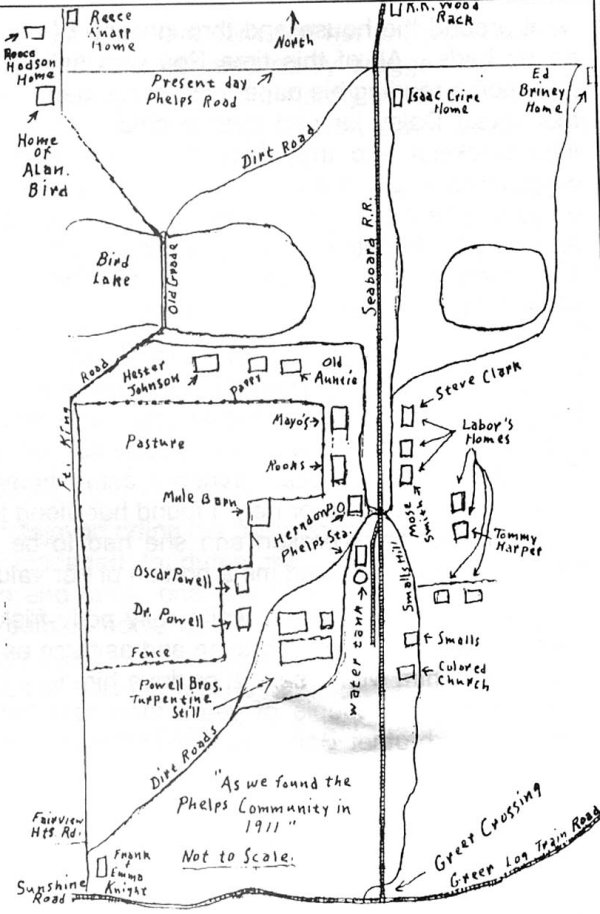HISTORY OF PASCO COUNTY
Herndon (Phelps)
 Herndon was a mostly black community along the railroad tracks about a half-mile
south of Phelps Road. The community developed around a turpentine still owned by the Powell Brothers some time after 1900. It
ceased to exist by 1920.
Herndon was a mostly black community along the railroad tracks about a half-mile
south of Phelps Road. The community developed around a turpentine still owned by the Powell Brothers some time after 1900. It
ceased to exist by 1920.
The Herndon post office, which was established on March 15,
1886, was a “flag stop” on the railroad.
In his historical account, David Cripe refers to the railroad station
as Phelps Station.
The Herndon post office was discontinued in 1917.
The area was known as the Phelps community both before and after it was
known as Herndon, although the name Phelps does not appear on maps.
The boundaries of the Phelps community were generally considered to be Phelps Road on the north,
Ft. King Road on the east, and Sunshine Road on the south. It ended a short distance east of the railroad,
and did not extend all the way the US 301, which was built about half a mile farther east, one mile east of Ft. King Road.
The Sand Pond School at Ft. King Road and Bozeman Road and the Independence School served the children of the Herndon community.
The History of Zephyrhills 1821-1921 by Rosemary W. Trottman has:
The completion of the F. R. & N. made some changes in Abbott. Mr. Phelps moved his distillery
across the tracks and the Hodson-Donnaly team did the brick work for resetting this first turpentine
distillery. Mr. Herndon, who had a sawmill in the pines to the east of Lake Buddy,
moved South to locate at Phelps, which became a flagstop on the railroad. The workers who lived in more or less
temporary homes about both the mill and the “still” attended the Independence and Sand Pond schools. Appolonia Osburn,
soon married to Brantley Smith, taught at what in the last year of life she called the Phelps School, but in school
records is Independence.
It Took a Lot of Living to Fill Those 90 Years by David I. Cripe has:
The road running by the school was a sandy dirt road which
wove its way south-westerly through the woods, over the hill, and around
a small lake to the small metropolis of Phelps Station. The settlement
included the Herndon Post Office and a turpentine still operated by the
Powell brothers, also about a dozen houses for employees.
The Herndon P. O. was about twelve feet square and was run by a Mr. Eddie Vogt (who was also a master photographer)
[Edwin M. Vogt]. Mr. Vogt picked up the mail bag, which had been kicked out of the mail car door and the train went through
(northbound at 10:00 AM and southbound at 4:14 PM). Mr. Vogt hung the outgoing mail bag on an arm contraption beside the tracks
and it was snagged by amovable arm which the mail clerk extended from the mail car door. After the mail was sorted,
a Mr. George Overstreet would deliver mail addressed to Greer, Fl. to the Greer P. O. for distribution. In those
days, a letter addressed to I. Cripe, Herndon, Fl. came through with no problem. …
The little house shown just north of the school house beside 301 was the home of a black family we knew as Aunt Sally Richarddson.
She had about seven boys.
The map below shows the concentrated settlement is less than a half-mile south of Phelps Road,
immediately south of Bird Lake. The homes of Reece Knapp, Reece Hodson and Alan Bird are shown in the
upper left-hand corner. These were all white families, as were Isaac Cripe and Ed Briney.
Moving south of the lake, the homes labeled Hester Johnson, Potts, and “Old Annie” were black families,
as were all of the families “on the other side of the tracks.” Oscar Powell and Dr. Powell were white.
The map shows a black church.
Information from Robert Dew, using a history written by his uncle David Cripe.
The map below was published in It Took A Lot Of Living to Fill Those 90 Years, ©1996 David I. Cripe. It is reproduced
here with permission of the author’s son.
 |


 Herndon was a mostly black community along the railroad tracks about a half-mile
south of Phelps Road. The community developed around a turpentine still owned by the Powell Brothers some time after 1900. It
ceased to exist by 1920.
Herndon was a mostly black community along the railroad tracks about a half-mile
south of Phelps Road. The community developed around a turpentine still owned by the Powell Brothers some time after 1900. It
ceased to exist by 1920.